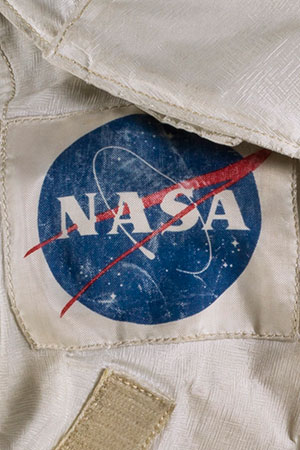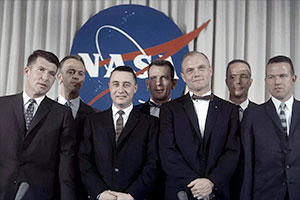July 15, 2024 — One of the world's best known — and certainly most-traveled — logos is 65 years old.
Since its announcement on July 15, 1959, the insignia representing NASA, or the National Aeronautics and Space Administration, has adorned both t-shirts and spacesuits, been reproduced as large as 10 stories tall and reached the surfaces of both the moon and Mars. The red, white and blue logo is NASA's oldest official identifier, even predating the agency's formal seal.
Designed by James Modarelli, the then-head of the research reports division at NASA's Lewis Research Center (today, Glenn Research Center) in Cleveland, Ohio, the NASA insignia is comprised of a circle symbolizing space; a supersonic wing for aeronautics; and a spacecraft in orbit. The logo reads "NASA" in bold letters across its center.
"As we celebrate the legacy of this iconic logo, we acknowledge the essential contributions of all the career fields involved in making the agency's missions possible," said Kristen Parker, Glenn's communications director, in a statement. "It's not just rocket scientists here at NASA."
Modarelli created the logo at the request of NASA's first administrator, Keith Glennan, using elements from his design for the agency's seal. President Dwight D. Eisenhower signed an executive order authorizing the seal in November 1959, around the same time that NASA's first orders for stationery, lapel pins and decals with Modarelli's logo were completed and Modarelli, himself, transferred to NASA Headquarters in Washington, DC to become the exhibits director. (Modarelli later returned to Lewis [Glenn] in 1961.)
One of the first public appearances of the new logo was at the April 1959 press conference where NASA introduced its original Mercury astronauts. The hand-painted sign, which hung from the curtains behind the seven men, reversed the direction of the spacecraft in its orbit and had less prominent star fields than would later dot the insignia's background.
For 15 years, NASA emblazoned Modarelli's logo on its air and spacecraft; on its building walls and hangar roofs; on astronauts' ground and flight gear; and everywhere and on everything else the agency wanted identified as its own. Then in 1974, as part of a government effort to modernize the look of all of the U.S. federal agencies, NASA replaced Modarelli's artwork with a more sleek logotype created by New York design firm partners Richard Danne and Bruce Blackburn.
To distinguish the old from the new, Modarelli's logo became known as the "meatball" (versus Danne and Blackburn's "worm"), due to some feeling that it was messy, like a meatball atop of a bowl of spaghetti.
Although no longer official and excluded from the graphics standard manual that dictated the use of the worm, the meatball continued to be used within the agency. Perhaps most prominently, were the garments that NASA's new space shuttle astronauts wore to train and to launch. Beginning with the STS-7 crew in 1983, the powder blue flight suits and coveralls had both worm and meatball embroidered patches.
Then in 1992, NASA Administrator Dan Goldin unilaterally decided to retire the worm and use only the meatball as his way of revitalizing excitement among the workforce. This led to the Modarelli's logo being added to the left wings of the space shuttle orbiters, to the exterior of the "Destiny" U.S. laboratory on the International Space Station and, at an astonishing 110 by 132 feet (34 by 40 meters), to an outside wall of the Vehicle Assembly Building at Kennedy Space Center in Florida.
The first rover to wheel across a planet other than Earth, NASA's Mars Pathfinder "Sojourner," did so with the meatball affixed to its body, just as the first astronauts to walk on the moon wore almost 30 years earlier.
The logo was also re-adopted by the public, with Hollywood studios applying to use it in their feature films; Snoopy donning it as NASA's on-going safety and STEM mascot; and Lego making it the first insignia to adorn its minifigures (as opposed to fictional logos created by the toy company).
"NASA's brand elements are wildly popular," said Aimee Crane, merchandising and branding clearance manager for NASA. "Every year, the agency receives requests to merchandise more than 10,000 NASA-inspired items."
For the last several years and continuing today into the future, the meatball has retained its status as NASA's official insignia, but now is used side-by-side with the worm logotype. Together they will launch with the first astronauts to return to the moon and those who ultimately go on to explore Mars as part of NASA's Artemis program. |
|

NASA's official insignia, nicknamed the "meatball," as worn on the moon by Apollo 11 astronaut Neil Armstrong in 1969. (Smithsonian)

NASA's then-newly named Mercury 7 astronauts stand in front of a pre-finalized version of the agency's insignia in April 1959. (NASA)

James Modarelli, as seen in 1997, posing with the NASA logo he designed. Modarelli died in 2002 at the age of 86. (NASA) |
